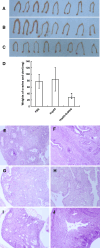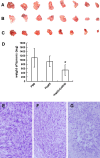Immunization with a recombinant GnRH vaccine fused to heat shock protein 65 inhibits mammary tumor growth in vivo
- PMID: 20803011
- PMCID: PMC11031030
- DOI: 10.1007/s00262-010-0911-4
Immunization with a recombinant GnRH vaccine fused to heat shock protein 65 inhibits mammary tumor growth in vivo
Abstract
Gonadotrophin-releasing hormone (GnRH) is the prime decapeptide hormone in the regulation of mammalian reproduction. Active immunization against GnRH has been a good treatment option to fight against hormone-dependent disease such as breast cancer. We designed and purified a novel protein vaccine Hsp65-GnRH(6) containing heat shock protein 65 (Hsp65) and six copies of GnRH in linear alignment. Immunization with Hsp65-GnRH(6) evoked strong humoral response in female mice. The generation of specific anti-GnRH antibodies was detected by ELISA and verified by western blot. In addition, anti-GnRH antibodies effectively neutralized endogenous GnRH activity in vivo, as demonstrated by the degeneration of the ovaries and uteri in the vaccinated mice. Moreover, the growth of EMT-6 mammary tumor allografts was inhibited by anti-GnRH antibodies. Histological examinations have shown that there was increased focal necrosis in tumors. Taken together, our results showed that immunization with Hsp65-GnRH(6) elicited high titer of specific anti-GnRH antibodies and further led to atrophy of reproductive organs. The specific antibodies could inhibit the growth of EMT-6 murine mammary tumor probably via an indirect mechanism that includes the depletion of estrogen. In view of these results, the protein vaccine Hsp65-GnRH(6) appears to be a promising candidate vaccine for hormone-dependent cancer therapy.
Figures




Similar articles
-
Inhibition effects on liver tumors of BALB/c mice bearing H22 cells by immunization with a recombinant immunogen of GnRH linked to heat shock protein 65.Vaccine. 2007 Sep 28;25(39-40):6911-21. doi: 10.1016/j.vaccine.2007.07.034. Epub 2007 Aug 6. Vaccine. 2007. PMID: 17728021
-
Immunization with a recombinant GnRH vaccine conjugated to heat shock protein 65 inhibits tumor growth in orthotopic prostate cancer mouse model.Cancer Lett. 2008 Feb 8;259(2):240-50. doi: 10.1016/j.canlet.2007.10.011. Epub 2007 Nov 26. Cancer Lett. 2008. PMID: 18039558
-
A synthetic gonadotropin-releasing hormone (GnRH) vaccine for control of fertility and hormone dependent diseases without any adjuvant.Vaccine. 2005 Sep 23;23(40):4834-43. doi: 10.1016/j.vaccine.2005.05.010. Vaccine. 2005. PMID: 15996796
-
Vaccines for control of fertility and hormone dependent cancers.Int J Immunopharmacol. 1992 Apr;14(3):511-4. doi: 10.1016/0192-0561(92)90183-l. Int J Immunopharmacol. 1992. PMID: 1618603 Review.
-
Gonadotropin-releasing hormone/human chorionic gonadotropin beta based recombinant antibodies and vaccines.J Reprod Immunol. 2009 Dec;83(1-2):158-63. doi: 10.1016/j.jri.2009.08.008. Epub 2009 Oct 24. J Reprod Immunol. 2009. PMID: 19854518 Review.
Cited by
-
Novel molecules as the emerging trends in cancer treatment: an update.Med Oncol. 2022 Jan 4;39(2):20. doi: 10.1007/s12032-021-01615-6. Med Oncol. 2022. PMID: 34982273 Review.
-
Mycobacteria-Based Vaccines as Immunotherapy for Non-urological Cancers.Cancers (Basel). 2020 Jul 5;12(7):1802. doi: 10.3390/cancers12071802. Cancers (Basel). 2020. PMID: 32635668 Free PMC article. Review.
References
Publication types
MeSH terms
Substances
LinkOut - more resources
Full Text Sources
Research Materials

